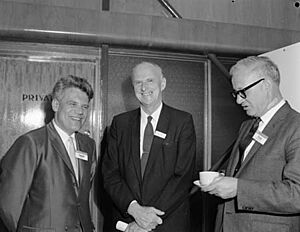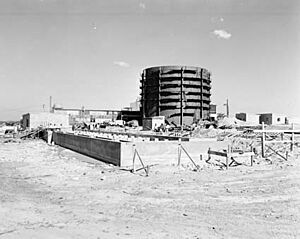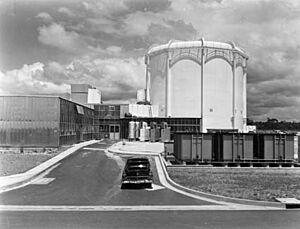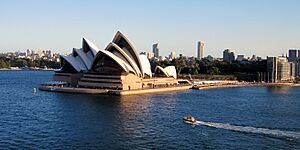Philip Baxter facts for kids
Quick facts for kids
Sir
Philip Baxter
|
|
|---|---|
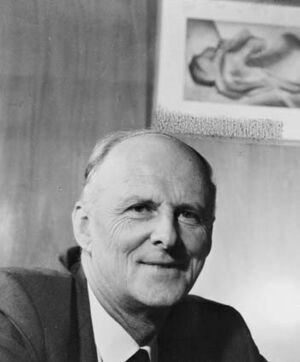
Baxter in 1965
|
|
| Born | 7 May 1905 Machynlleth, Wales
|
| Died | 5 September 1989 (aged 84) Haberfield, Sydney, Australia
|
| Alma mater | University of Birmingham (BSc, 1925; MSc, 1926; PhD, 1928) |
| Awards | |
| Scientific career | |
| Fields | Chemical engineering |
| Institutions |
|
| Thesis | The combustion of carbonic oxide (1928) |
| Doctoral advisor | F. H. Burstall |
Sir John Philip Baxter (7 May 1905 – 5 September 1989) was a brilliant British chemical engineer. He became the second leader of the University of New South Wales (UNSW) in 1953. Under his guidance, the university grew very quickly. It became one of Australia's fastest-growing and most diverse universities. A college at UNSW, Philip Baxter College, is named in his honor.
Baxter was born in Wales but grew up in England. He joined Imperial Chemical Industries (ICI) as a chemical engineer. There, he studied the chemistry of chlorine and fluorine. During World War II, he helped the British nuclear weapons program, called Tube Alloys. He also assisted the American Manhattan Project in Oak Ridge, Tennessee.
In 1949, Baxter moved to Australia to become a professor at UNSW. He became a strong supporter of nuclear power for Australia. He led the Australian Atomic Energy Commission for many years. He also oversaw the building of Australia's main nuclear reactor, HIFAR. Beyond science, he founded the National Institute of Dramatic Art (NIDA). He also helped finish the famous Sydney Opera House.
Contents
Early Life and Education
John Philip Baxter was born in Machynlleth, Wales, on 7 May 1905. His father and mother both worked for the British Post Office. The family later moved to Hereford, England, where Philip attended Hereford High School for Boys. He enjoyed playing tennis in his free time.
Baxter was very smart and passed his university entrance exams at age 14. However, he was too young to attend university then. He tried again and finally entered the University of Birmingham at 16. He studied science and was interested in metallurgy. He earned his first degree in 1925 and his master's degree in 1926. In 1928, he completed his PhD, studying how carbonic oxide burns.
Working at Imperial Chemical Industries
After university, Baxter joined Imperial Chemical Industries (ICI) in Billingham. He worked as a research engineer. He later moved to ICI's General Chemicals Division in Widnes. There, he became the head of the Central Laboratory.
His team focused on the chemistry of chlorine and fluorine. They created new products using chlorine, like different solvents and an insecticide called Lindane. Baxter even received several patents for his inventions. By 1935, he became the Research Manager for the division.
Besides his scientific work, Baxter was also involved in local government. He was elected to the Widnes Municipal Council in 1939. He served on the council until 1949.
Helping with Nuclear Projects
In 1940, during World War II, physicist James Chadwick asked Baxter for a sample of uranium hexafluoride. This was for a secret British project called Tube Alloys. The goal was to build an atomic bomb. Baxter helped set up a small factory in Widnes to produce larger amounts of this material.
In 1944, the Americans needed help with their own nuclear project, the Manhattan Project. They asked for someone with experience in uranium chemistry. Baxter was sent to Oak Ridge, Tennessee, to assist them. He later returned with his family to help coordinate research and production. For his important work during the war, Baxter received an award in 1946.
After the war, Baxter returned to ICI. He continued to work on uranium products. He also helped design a plant to extract plutonium. However, ICI decided not to focus on nuclear energy. This disappointed Baxter, who believed in its importance.
Leading the University of New South Wales
In 1949, Baxter heard that the New South Wales University of Technology in Australia needed a professor of chemical engineering. He applied and got the job. He and his family moved to Sydney in 1950. Baxter became the head of the new School of Chemical Engineering.
Even though he had no teaching experience, he was a good lecturer. He worked closely with his first students. He changed the university's diploma courses into bachelor's degrees. The first chemical engineering students graduated in 1952. In 1953, his school was the first to move to the university's new campus in Kensington.
In 1952, Baxter became the university's deputy director. He was then elected director in 1953. When the university gained more independence in 1954, Baxter became its vice-chancellor in 1955.
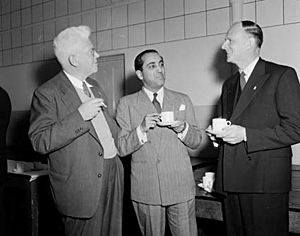
Under his leadership, the university changed its name to the University of New South Wales (UNSW) in 1958. Baxter created many new and unique schools. He started schools for Nuclear Engineering, Textile Technology, and Food Technology. He also established a School of Business Administration. He believed the university's main goal was to train engineers and technologists for industries.
Baxter wanted the university to grow quickly. Student numbers increased from about 3,751 in 1955 to over 15,988 when he retired in 1969. He also created Unisearch Limited in 1959. This company provided expert help from the university to industries.
The Atomic Knight
In 1949, the Australian government created a committee to advise on nuclear power. Baxter was a member of this committee. In 1952, the Australian Atomic Energy Commission (AAEC) was formed. Baxter became its vice-chairman.
He became the chairman of the AAEC in 1957. He also represented Australia on the Board of Governors of the International Atomic Energy Agency. This agency promotes the peaceful use of nuclear energy worldwide.
Baxter wanted Australia to have a powerful nuclear reactor. He disagreed with plans for a small experimental one. He pushed for a "real reactor." The government approved the High Flux Australian Reactor (HIFAR). Construction began in 1955 at Lucas Heights. HIFAR started operating in 1958.
By 1969, the AAEC had grown significantly under Baxter. It had over 1,000 staff and a large budget. The AAEC searched for uranium in Australia and developed technology for nuclear reactors.
Baxter also believed Australia should have the ability to produce nuclear weapons for defense. He proposed building a facility to create weapons-grade plutonium. In 1969, Prime Minister John Gorton approved plans for a nuclear reactor at Jervis Bay. However, the project was later canceled. Baxter continued to advocate for Australia to develop nuclear weapons.
For his work with the Atomic Energy Commission, Baxter received several honors. He was made a Companion of the Order of St Michael and St George in 1959. He was also made a Knight Commander of the Order of the British Empire in 1965.
Arts and Lasting Impact
Baxter had a passion for drama. He had performed in plays himself. In 1958, he founded the National Institute of Dramatic Art (NIDA). NIDA became one of the world's best drama schools. Many famous actors and directors, like Cate Blanchett and Mel Gibson, studied there.
From 1969 to 1975, Baxter was the chairman of the Sydney Opera House Trust. This was a challenging job. The original architect had left, and the construction was behind schedule and over budget. Baxter took charge and helped bring the iconic Sydney Opera House to completion. It officially opened on 20 October 1973.
Baxter received honorary doctorates from several universities. Philip Baxter College at UNSW was named after him in 1966. Sir Philip Baxter passed away on 5 September 1989. He left behind a significant legacy in science, education, and the arts in Australia.
Images for kids
-
During a two-day symposium on "Atomic Power in Australia" at the New South Wales University of Technology, Sydney, which began on 31 August 1954, Professors Marcus Oliphant (left), Homi Jehangir Bhabha (centre) and Philip Baxter, meet over a cup of tea


